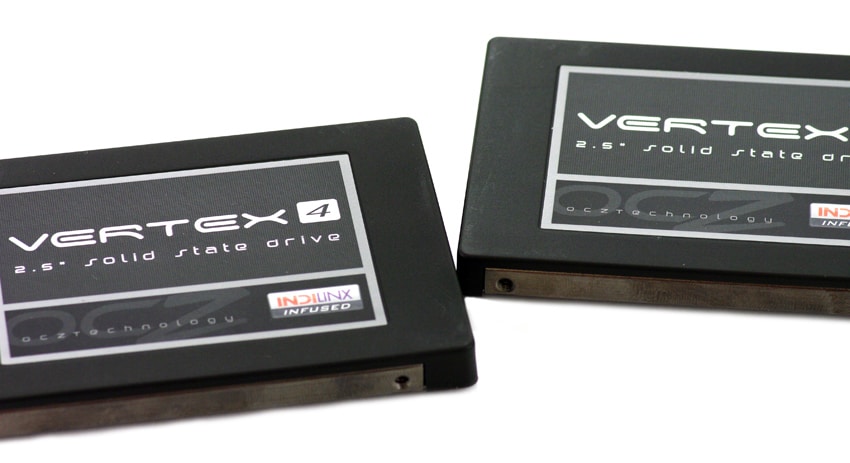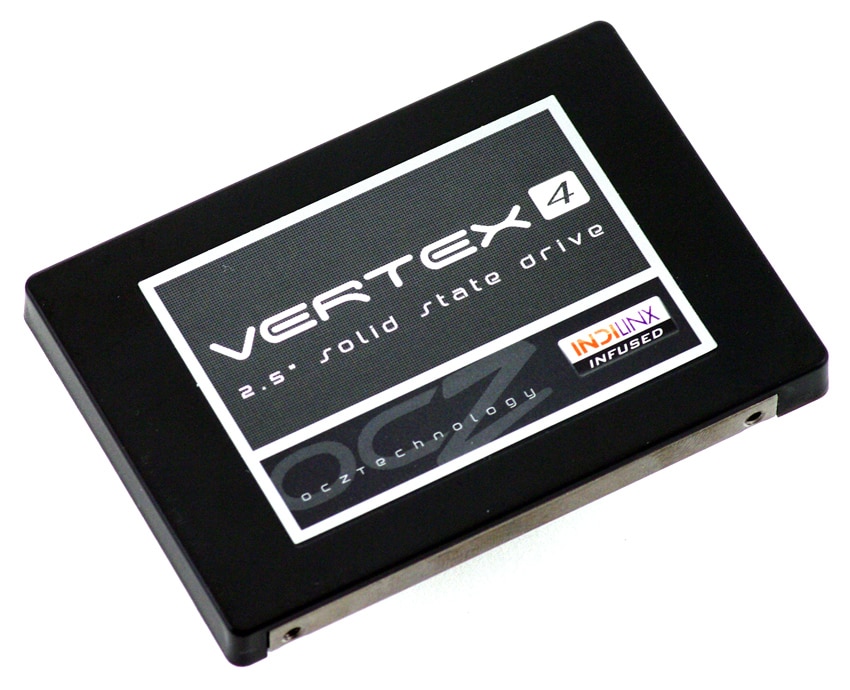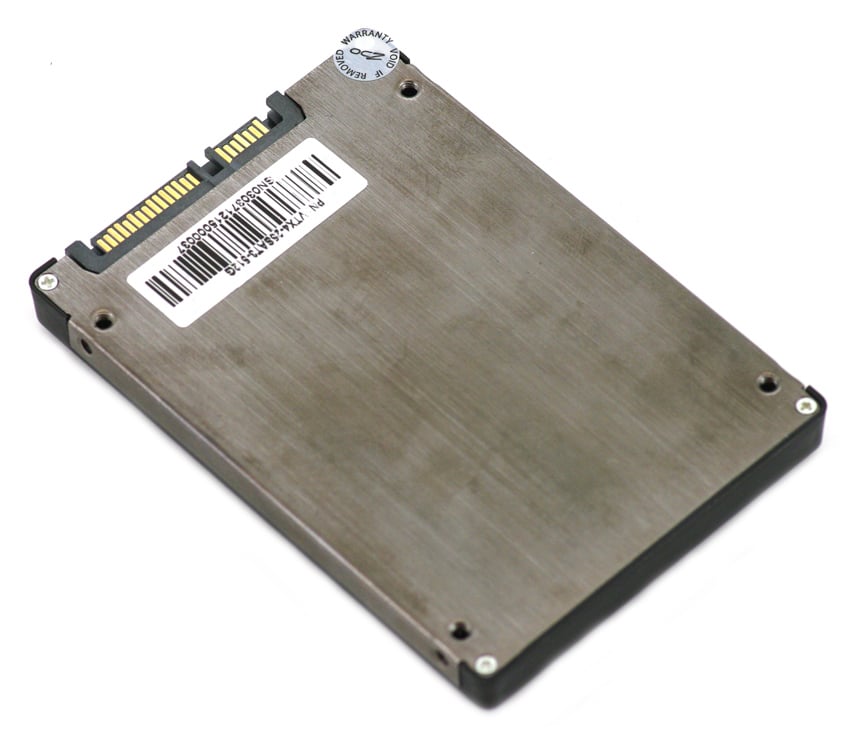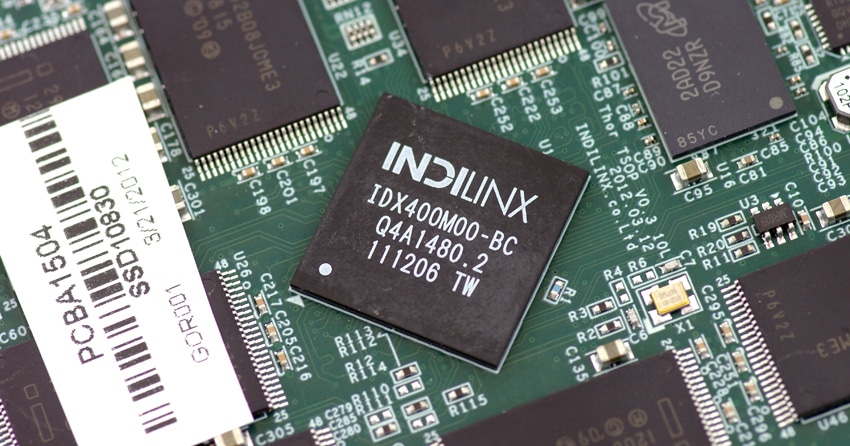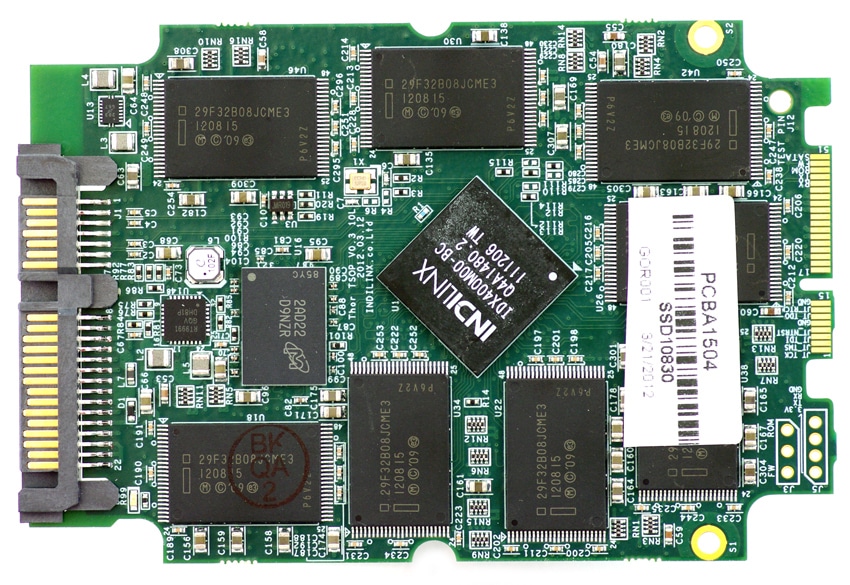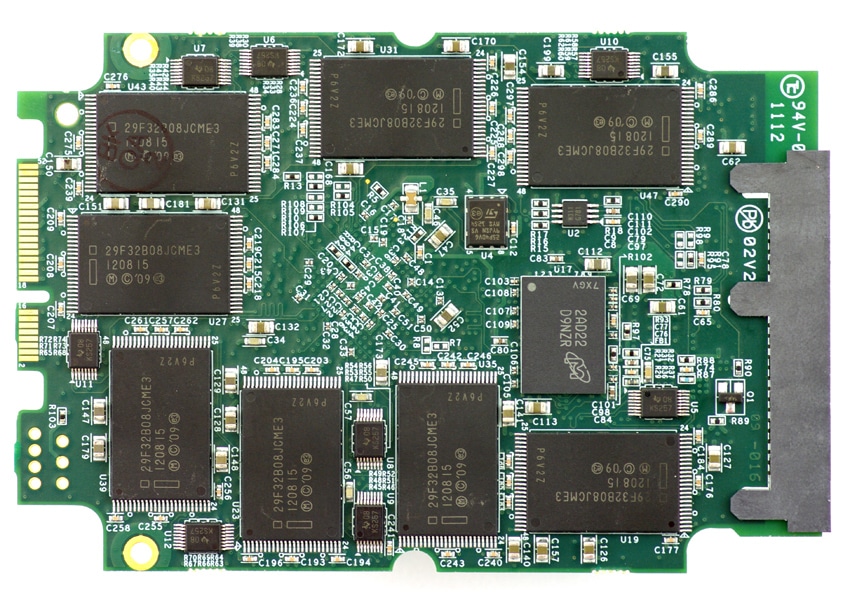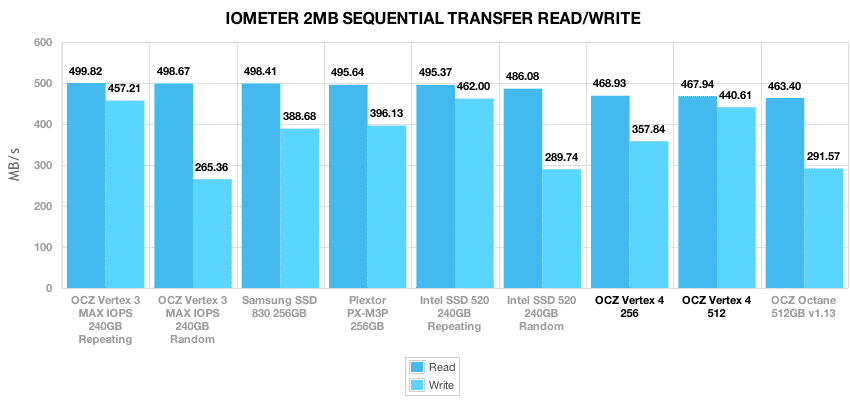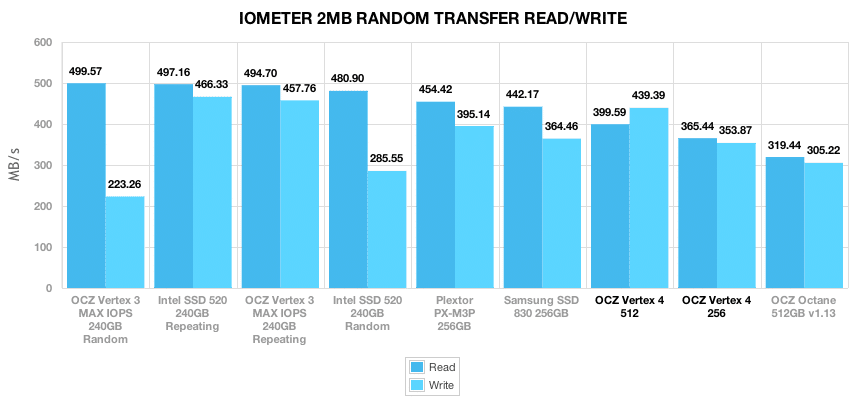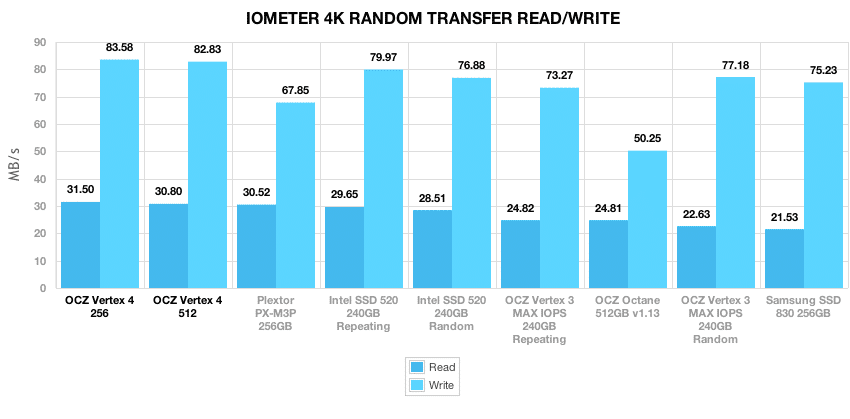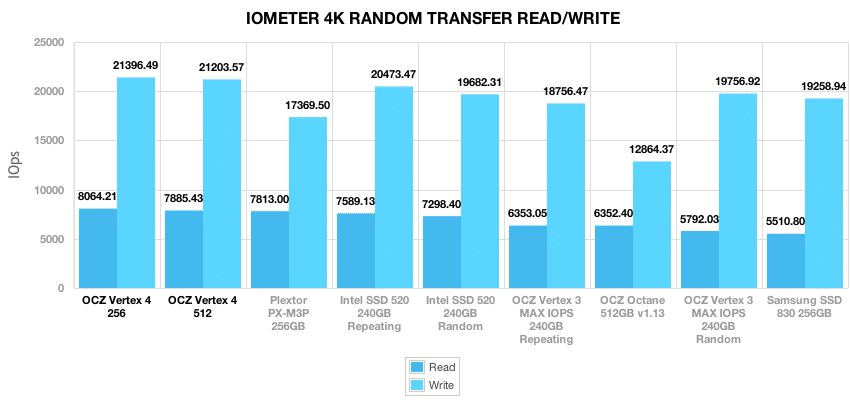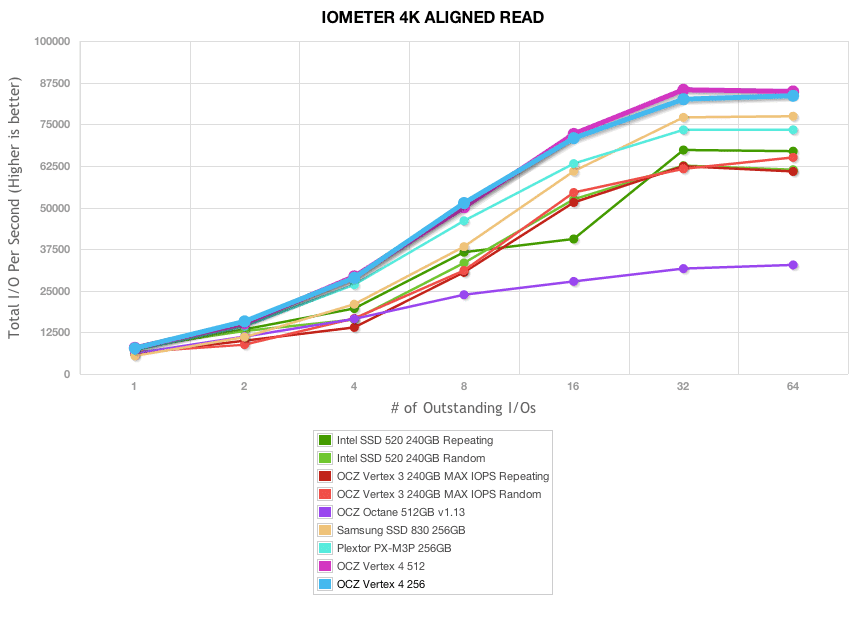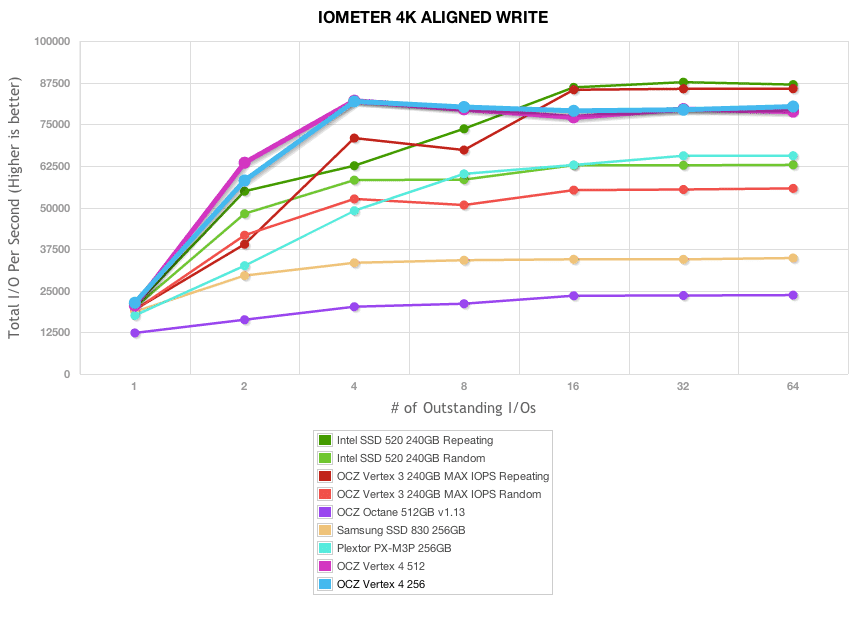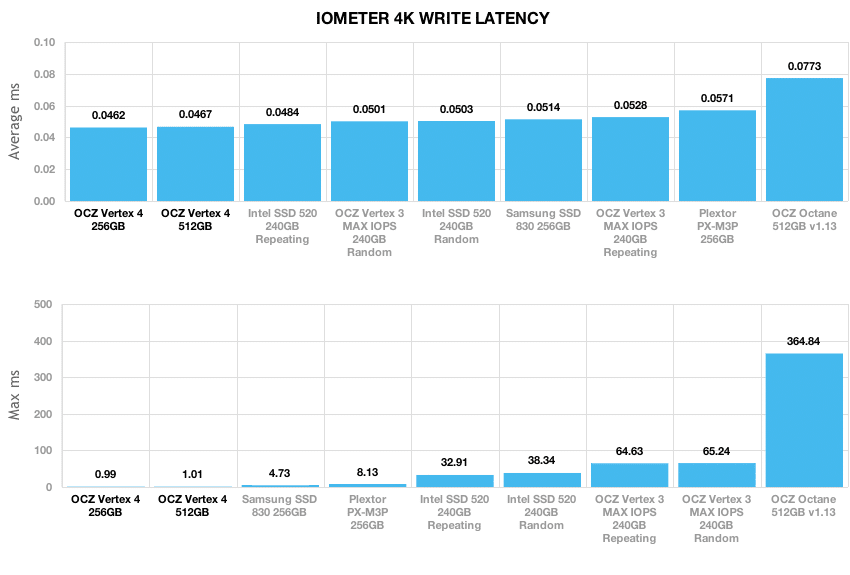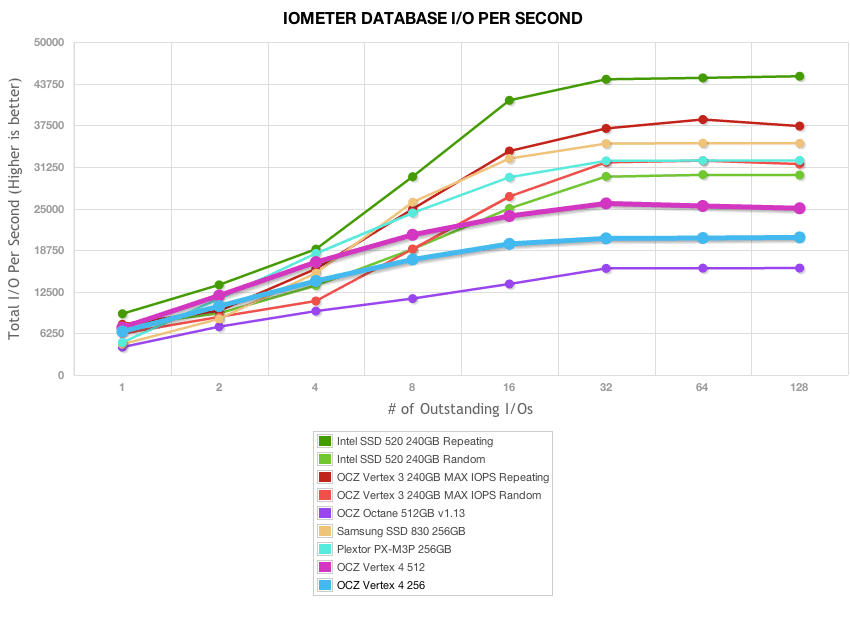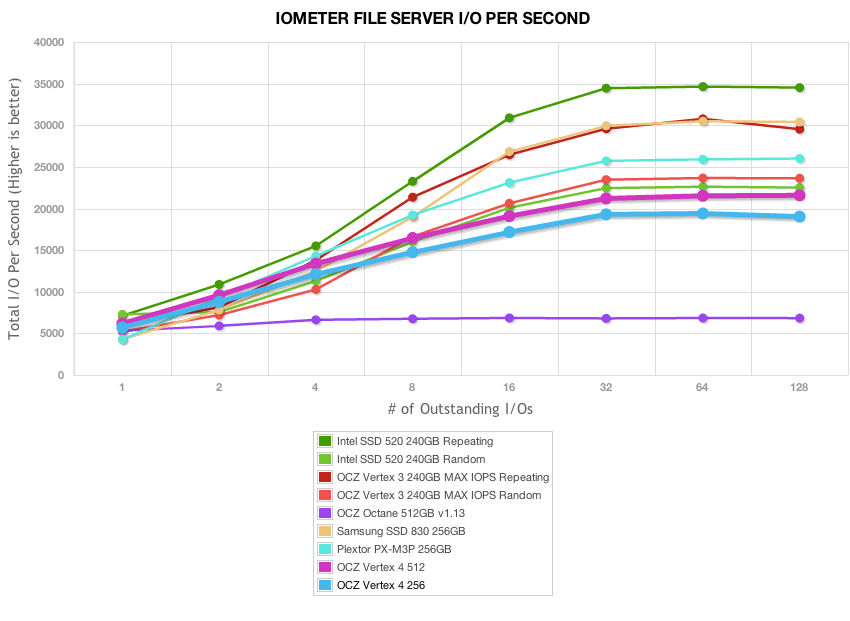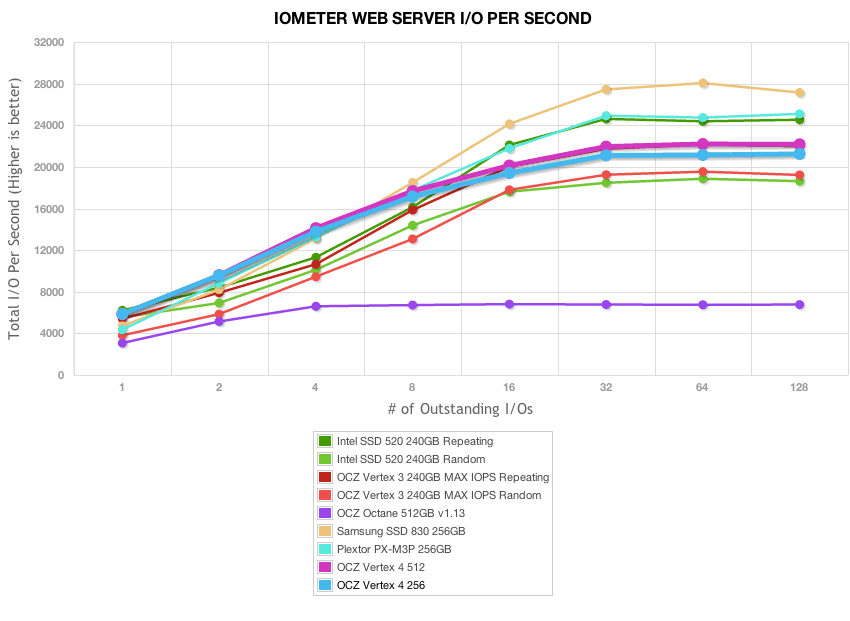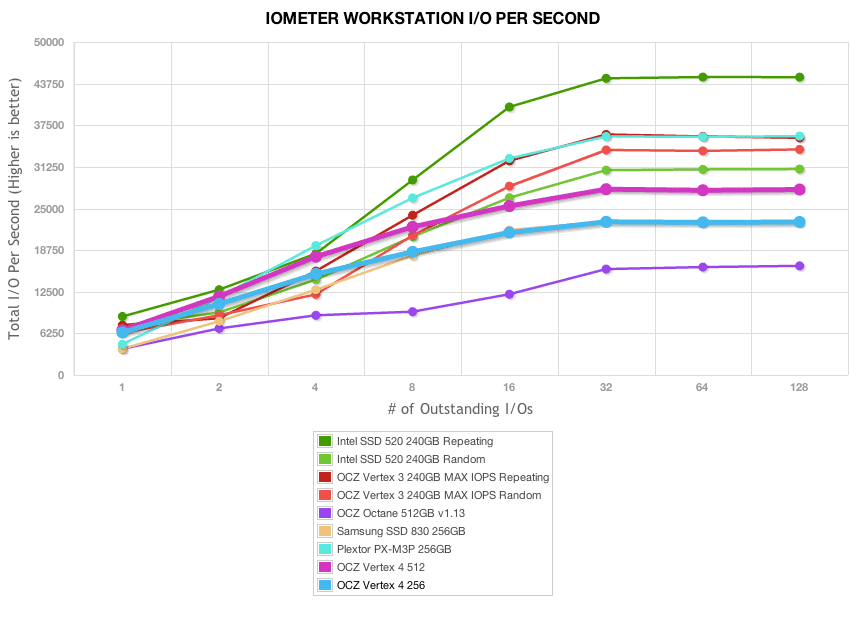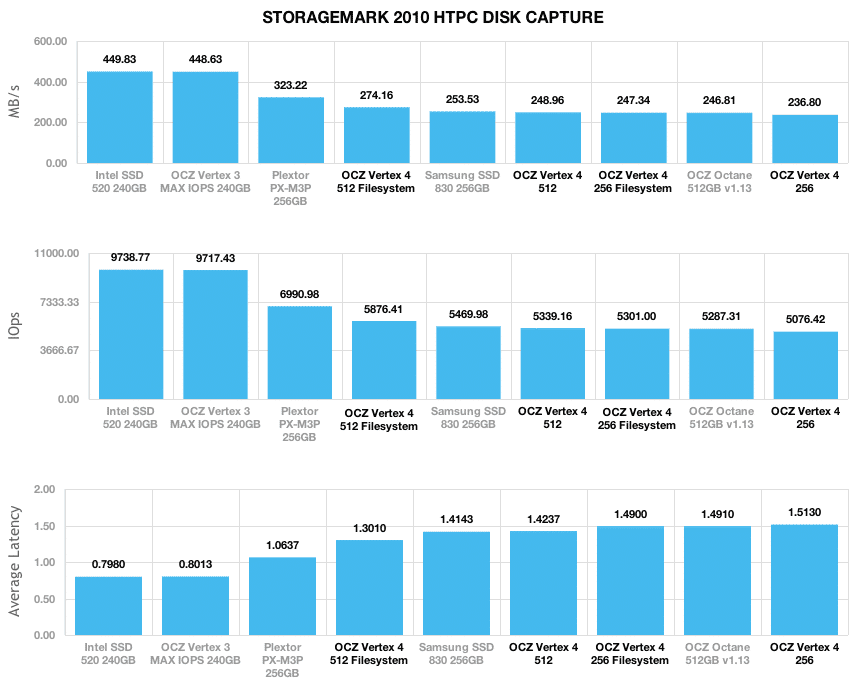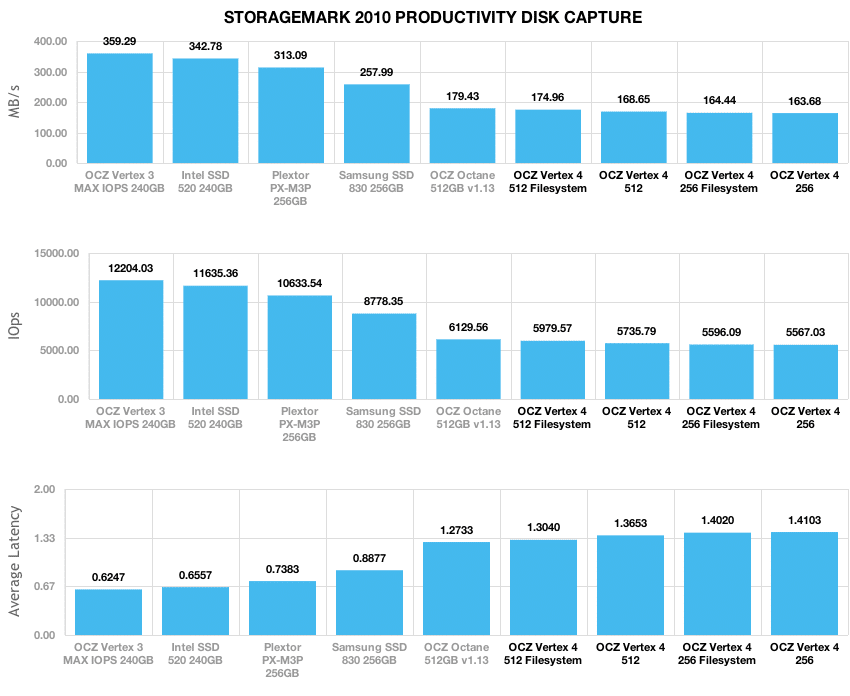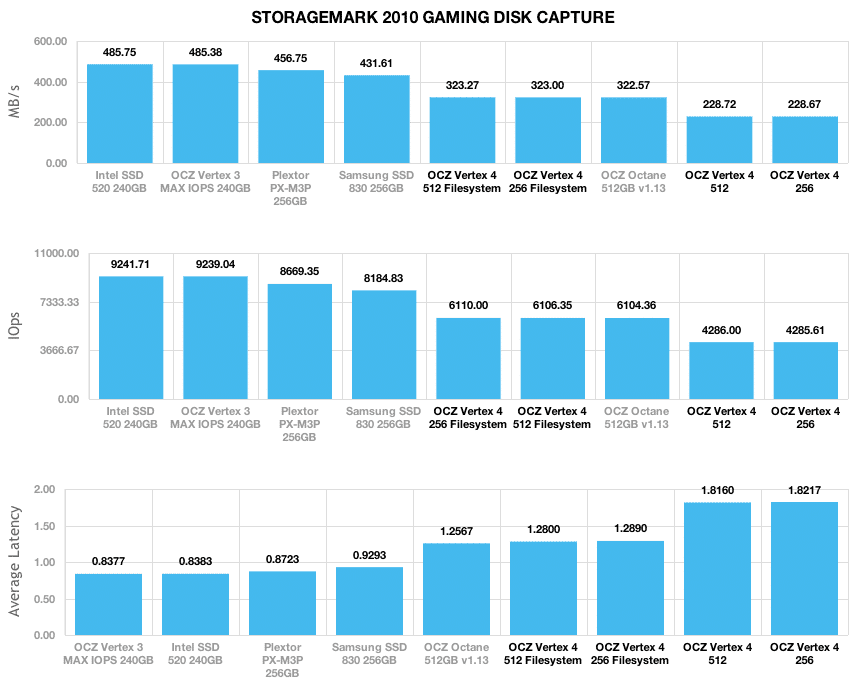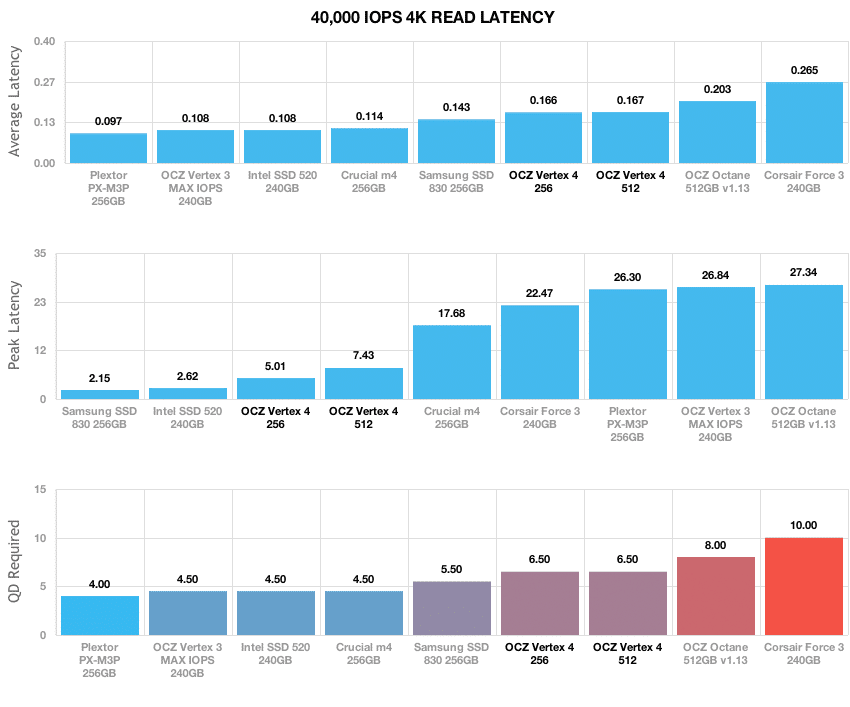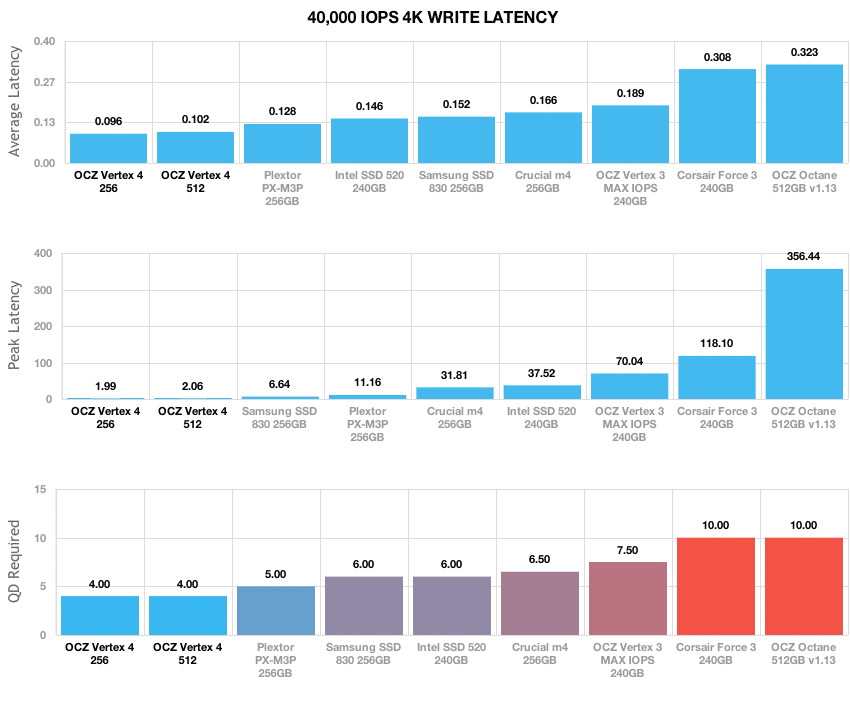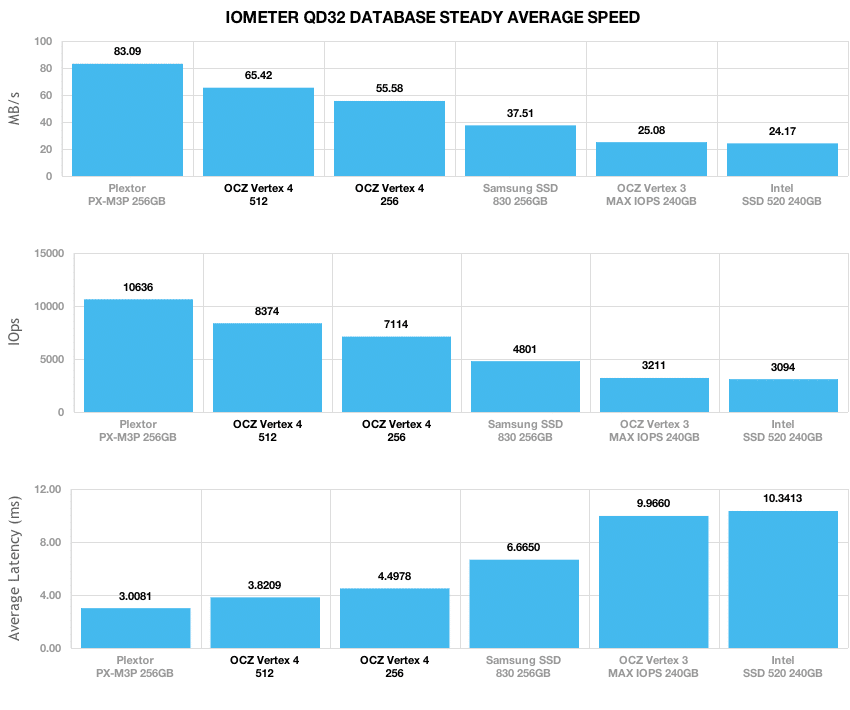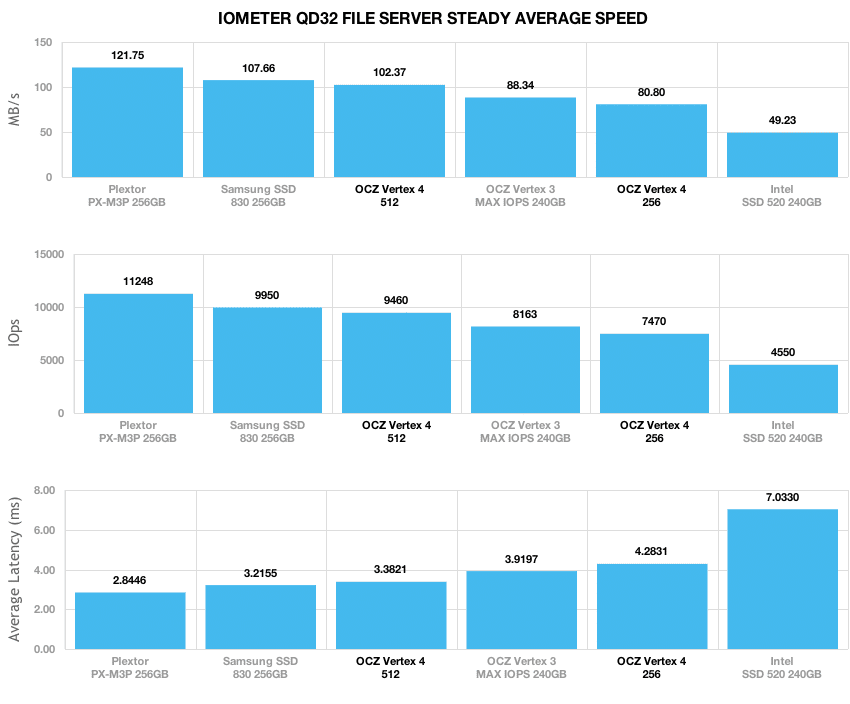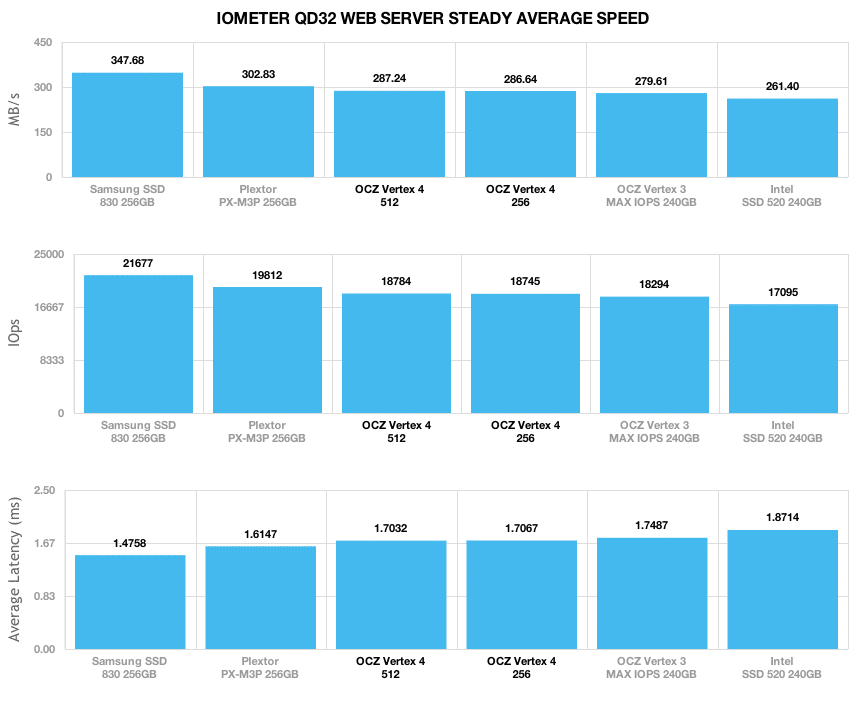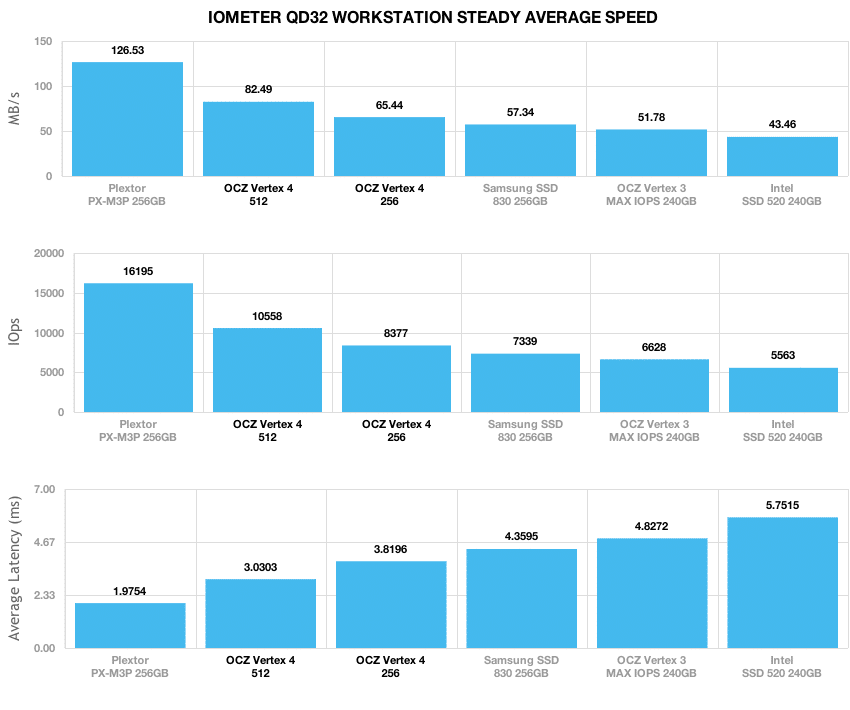The OCZ Vertex 4 SSD is a bold step for the company – OCZ has abandoned the high-flying LSI SandForce controller for their own Indilinx Everest 2 in the flagship Vertex 4 client SSD. It could be said that OCZ has had as much to do with SandForce’s success as SandForce has had with OCZ’s. But OCZ had long wanted to own their own controller technology, buying Indilinx to bring that key IP in-house. The first consumer-facing products of the updated Indlinx controller were the Octane and Petrol SSDs, which did well with market validation. With the Vertex 4 on Everest 2, OCZ goes all-in, making the commitment to go forward in the consumer space at least, with their own controllers and technologies.
The OCZ Vertex 4 SSD is a bold step for the company – OCZ has abandoned the high-flying LSI SandForce controller for their own Indilinx Everest 2 in the flagship Vertex 4 client SSD. It could be said that OCZ has had as much to do with SandForce’s success as SandForce has had with OCZ’s. But OCZ had long wanted to own their own controller technology, buying Indilinx to bring that key IP in-house. The first consumer-facing products of the updated Indlinx controller were the Octane and Petrol SSDs, which did well with market validation. With the Vertex 4 on Everest 2, OCZ goes all-in, making the commitment go forward in the consumer space at least, with their own controllers and technologies.
We’ve long praised those who own their own controllers for various reasons, the primary being improved reliability and support. Thanks to having engineering teams in house who understand the controller and the rest of the board’s components, it’s easier to both engineer the drive and firmware exactly as they like, as well as offer responsive support if issues arise. OCZ also gets the chance to engineer the controller exactly how they want, instead of having to buy one off the shelf, like the dozens of others who buy SandForce controllers.
OCZ differentiates the Vertex 4 from other enthusiast grade SSDs with both technology and performance. On the technology side, Everest 2 SSDs benefit from what OCZ calls Ndurance 2.0, a collection of technologies that includes reduced write amplification without compression, multi-level EDD, adaptive NAND flash management. They also offer auto-encryption, AES-256 support and Redundant NAND Array technology, which protects from NAND flash failures and uncorrectable data errors by generating parity data information, striping it across multiple NAND cells.
On the performance front, the performance scales up with capacity. The top-end 512GB Vertex 4 offers sequential reads up to 535MB/s, writes up to 475MB/s and random read IOPS of 95,000 (4K QD32) and writes of 85,000. OCZ touts the Vertex 4 as a superior performer beyond the basics though, with industry-leading 4K read performance and capable of handling compressible and incompressible data in equal measure.
The OCZ Vertex 4 will ship initially in three capacities; 128GB, 256GB and 512GB with MSRPs of $179, $349, and $699 respectively. The Vertex 4 carries a standard 9.5mm 2.5″ form factor with SATA 6Gb/s interface and comes with a 3.5″ desktop bay adapter. OCZ offers a standard warranty of five years, which is the high point for client SSDs.
OCZ Vertex 4 Specifications:
- Capacities
- 128GB (VTX4-25SAT3-128G)
- Max Read: 535MB/s
- Max Write: 200MB/s
- Random Read IOPS: 90,000 (4K QD32)
- Random Write IOPS: 85,000 (4K QD32)
- Max IOPS: 120,000 (512B Random Read)
- 256GB (VTX4-25SAT3-256G)
- Max Read: 535MB/s
- Max Write: 380MB/s
- Random Read IOPS: 90,000 (4K QD32)
- Random Write IOPS: 85,000 (4K QD32)
- Max IOPS: 120,000 (512B Random Read)
- 512GB (VTX4-25SAT3-512G)
- Max Read: 535MB/s
- Max Write: 475MB/s
- Random Read IOPS: 95,000 (4K QD32)
- Random Write IOPS: 85,000 (4K QD32)
- Max IOPS: 120,000 (512B Random Read)
- 128GB (VTX4-25SAT3-128G)
- Indlilinx Everest 2 Controller
- 2Xnm Synchronous MLC NAND
- DRAM Cache – up to 1GB
- SATA 6Gb/s interface
- 2.5″ form factor
- 9.5mm drive height
- Dimensions – 99.8 x 69.63 x 9.3 mm
- Weight – 101g
- MTBF – 2 million hours
- Data path protection – BCH ECC corrects up to 128 random bits/1KB
- Encryption – 256-bit AES-compliant, ATA Security Mode Features
- Power Consumption – Idle: 1.3 W Active: 2.5 W
- Operating Temperature – 0°C ~ 70°C
- Ambient Temperature – 0°C ~ 55°C
- Storage Temperature – -45°C ~ 85°C
- Shock Resistance – 1500G
- Five year warranty
Design and Build
OCZ has continuously evolved the design and construction of their popular consumer SSDs. Starting with an all-metal body with metal backing plate, OCZ updated it to a plastic top cover and metal base assembly part-way into the Vertex 3 product line. That design has carried over to the new OCZ Vertex 4, although the polished metal plate now has a semi-rough brushed metal finish. Apart from that and a mild texturing difference with the cover with a semi-matte finish, the drive is nearly identical to models found in other OCZ product families, apart from the sticker color.
For those that aren’t familiar with the product family designs, the Vertex line is black and silver, the Agility line is black and green, the Synapse Cache is black and blue, and the other Indilinx-powered Octane SSD is black and orange. This consistent color design has helped associate new products to existing lines, especially with established product families such as the Vertex or Agility-series.
The side and front of the OCZ Vertex 4 are rather simplistic, apart from the horizontal mounting holes for drive caddies or the power and SATA connections on the front to connect the SSD to a computer. For all software updates, OCZ offers the OCZToolbox, which also allows users to check the health of their SSD, secure erase it, as well as perform any future software updates. One thing any user should check before updating their SSD is if the firmware update is destructive or not, since if that’s the case you will need to backup all data otherwise it will be erased (even though this is important advice before any update).
The bottom of the Vertex 4 displays important drive information on a sticker including the serial number and part number. Also included is a warranty-voiding sticker over one of the four screws, which if tampered with takes away the drive’s warranty and support.
Disassembly
As a warning for those thinking about tearing into their new OCZ Vertex 4, know that you void your warranty in the process. Besides trying to get a physical confirmation on what the internals are, there really is no reason to open one of these up during normal usage.
The OCZ Vertex 4 is very easy to take apart with a Phillips-head screwdriver. After removing four screws around the perimeter and breaking through the warranty sticker, the top cover comes loose exposing the PCB inside. The circuit board is held in place with two additional screws, with a single thermal pad between metal bottom cover and the Indilinx processor. As consumer and enterprise SSDs push the envelope in terms of performance, paying attention to drive thermals is increasingly important.
At the heart of the new OCZ Vertex 4 is an Indilinx IDX400M00-BC processor. This is by no means a surprise given the announcements of past investor calls and the preview at CES, but it does represent a radical shift for OCZ. The past two generations of Vertex SSDs have used the last two generations of LSI SandForce processors, including the SATA 3Gbs SF-1200 and later the SATA 6Gbs SF-2200. Since using Indilinx in the first Vertex SSD, OCZ has since acquired the company and and brought all R&D in-house. Moving away from LSI, to a relatively new controller in your flagship product is a gutsy move to say the least.
In the 512GB and 256GB Vertex 4 models we received for review, both use sixteen Intel IMFT synchronous 25nm NAND pieces, varying between 32GB and 16GB depending on overall capacity. This is the same NAND found inside the standard Vertex 3 as well as the Octane SSD. While no enhanced Vertex 4 has been announced utilizing Toggle NAND, such as the OCZ Vertex 3 Max IOPS, we wouldn’t rule out that combination in the future.
Synthetic Benchmarks
The OCZ Vertex 4 uses Intel’s 25nm synchronous MLC NAND, an Indilinx Everest 2 controller and a 6.0Gb/s SATA interface; our review units are 256GB and 512GB. The comparables used for this review include the following recently tested SSDs: Intel SSD 520 (240GB, SandForce SF-2281, Intel 25nm NAND, SATA), OCZ Vertex 3 MAX IOPS (240GB, SandForce SF-2281, Toshiba 32nm MLC NAND, SATA), OCZ Octane (512MB, Everest, Intel 25nm MLC NAND, SATA), Plextor PX-M3P (256GB, Marvell 9174, Toshiba 24nm MLC Toggle NAND, SATA) and the Samsung 830 (256GB, Samsung 3-core MCX controller, Samsung 2x nm Toggle NAND Flash, SATA). All IOMeter figures are represented as binary figures for MB/s speeds. All SSDs were tested on our client testing platform.
OCZ lists the Vertex 4 as having a peak sequential read speed of 535MB/s and a write speed of 475MB/s. We used IOMeter with a large-block transfer to see how the drive performed in our consumer test rig.
With a sequential large-block transfer the 512GB OCZ Vertex 4 measured 468MB/s read and 440MB/s write. The 256GB Vertex 4 measured 469MB/s read and 357MB/s write.
Our next test sticks with the same large-block transfer but switches from sequential to random transactions.
In a random large-block setting the OCZ Vertex 4 measured 399MB/s read and 439MB/s write with the 512GB model. The 256GB Vertex 4 measured 365MB/s read and 353MB/s write.
With the bread and butter of SSDs being their 4K random I/O speed, we look at low-queue depth performance, as well as expanded performance to see how well performance scales under higher queue depths.
At a queue depth of 1, the OCZ Vertex 4 offered the highest 4K read and write speeds from the group. The 512GB Vertex 4 measured 8,064 IOPS or 31.5MB/s 4K read and 21,396 IOPS or 83.58MB/s 4K write.
The next set of tests looks at expanded performance, to measure burst 4K read and write speed, as well as measure the peak I/O levels.
In our expanded 4K read chart the OCZ Vertex 4 quickly set itself apart from the competition at the lower queue depths, reaching a peak speed of 85,363 IOPS at a queue depth of 32.
In our ramped 4K write chart, the 512GB OCZ Vertex 4 flexed its muscles, peaking with speed of 82,091 IOPS at a queue depth of 4. At the higher queue depths the performance leveled off above 78,000 IOPS.
Expanding our QD1 4K test, we look at write latency of each SSD. Lower numbers are better, since it means less wait time for activity to process. Max latency is also important, although that number can change as the NAND wears over time. The OCZ Vertex 4 offered the lowest average and peak latency at QD1 in IOMeter. We measured an average latency of 0.0462ms from the 256GB model and 0.0467ms from the 512GB model with ultra-low peak latency of 0.99ms and 1.01ms respectively.
Our last group of consumer IOMeter synthetic benchmarks looks at mixed-load server profiles including Database, Workstation, File Server, and Webserver. The OCZ Vertex 4 in a mixed-workload setting offered strong performance, measuring middle of the pack compared to the other drives in this group, or SandForce-powered SSDs working with incompressible data.
Real-World Benchmarks
For the average consumer, trying to translate random 4K write speeds into an everyday situation is pretty difficult. It helps when comparing drives in every setting possible, but it doesn’t exactly work out into faster everyday usage or better game loading times. For this reason we turned to our StorageMark 2010 traces, which include HTPC, Productivity, and Gaming traces to help readers find out how a drive might rank under their conditions.
One of the new features of the OCZ Vertex 4 and the Indilinx firmware is ATA8 read look-ahead support. For the average user this translates into higher performance just going about your normal activities, but for a reviewer, this means making sure your benchmarks are compatible and showing these performance gains correctly. To date, our traces have interacted with SSDs and hard drives in an unformatted state. This method works great to exclude any OS interaction with our benchmarks, but also disables new file system benefits such as those found on the new Vertex 4. For that reason, we include both our standard trace run as well as one performed with a file system present on the drive being tested.
The first real-life test is our HTPC scenario. In this test we include: playing one 720P HD movie in Media Player Classic, one 480P SD movie playing in VLC, three movies downloading simultaneously through iTunes, and one 1080i HDTV stream being recorded through Windows Media Center over a 15 minute period. Higher IOps and MB/s rates with lower latency times are preferred. In this trace we recorded 2,986MB being written to the drive and 1,924MB being read. Our second real-life test covers disk activity in a productivity scenario. For all intents and purposes this test shows drive performance under normal daily activity for most users. This test includes: a three hour period operating in an office productivity environment with 32-bit Vista running Outlook 2007 connected to an Exchange server, web browsing using Chrome and IE8, editing files within Office 2007, viewing PDFs in Adobe Reader, and an hour of local music playback with two hours of additional online music via Pandora. In this trace we recorded 4,830MB being written to the drive and 2,758MB being read.
In our HTPC trace the OCZ Vertex 4 measured 248.95MB/s and 236.80MB/s average for the 512GB and 256GB capacities respectively in an unformatted state. Working inside a file-system the speeds increased to 274.16MB/s and 247.34MB/s.
Our second real-life test covers disk activity in a productivity scenario. For all intents and purposes this test shows drive performance under normal daily activity for most users. This test includes: a three hour period operating in an office productivity environment with 32-bit Vista running Outlook 2007 connected to an Exchange server, web browsing using Chrome and IE8, editing files within Office 2007, viewing PDFs in Adobe Reader, and an hour of local music playback with two hours of additional online music via Pandora. In this trace we recorded 4,830MB being written to the drive and 2,758MB being read.
In our Productivity trace the 512GB OCZ Vertex 4 measured 168MB/s average when tested in an unformatted state and 174MB/s with a file-system in place. The 256GB model measured 163MB/s average unformatted and 164MB/s with a file-system.
Our third real-life test covers disk activity in a gaming environment. Unlike the HTPC or Productivity trace, this one relies heavily on the read performance of a drive. To give a simple breakdown of read/write percentages, the HTPC test is 64% write, 36% read, the Productivity test is 59% write and 41% read, while the gaming trace is 6% write and 94% read. The test consists of a Windows 7 Ultimate 64-bit system pre-configured with Steam, with Grand Theft Auto 4, Left 4 Dead 2, and Mass Effect 2 already downloaded and installed. The trace captures the heavy read activity of each game loading from the start, as well as textures as the game progresses. In this trace we recorded 426MB being written to the drive and 7,235MB being read.
In our Gaming trace with a heavy focus on read activity, the 512GB OCZ Vertex 4 measured 228MB/s average unformatted, and sped up to 323MB/s with a file-system. The 256GB measured 228MB/s, and sped up to 323MB/s as well.
Latency Benchmarks
One of the emerging trends we see affecting storage devices in consumer and enterprise applications is a disconnect between IOPS or MB/s and latency. With flash products on the market usually saturating SATA 6Gb/s interfaces with 500MB/s+ sequential read or write speeds, or hitting large IOPS figures, trying to sort through all of it in a meaningful way can get difficult. To that end we are introducing a new line of tests specifically aimed at showcasing drive latency in a way that better mimics what the products could see in the real world. Few, if any consumer drives will ever be under peak queue depth load in a normal environment, so why only test drives under those conditions?
The first set of new latency benchmarks we are introducing look at a specific I/O goal; hitting 40,000 IOPS 4K read or write under our parameters. We set the upper limit at a queue depth of 10, and see how hard each drive has to work to hit that figure. We measure the average and peak latency and rank SSDs accordingly, as well as make note of the queue depth required to hit the target. Drives that come close to missing the target, or miss it entirely are shaded red or a gradient thereof, while drives that can meet that goal with less work are closer to blue. To account for SSDs that perform higher with compressible data, we use a data-pattern with 85% incompressibility level to partially mimic the real world.
Our first latency benchmark looks at 4K read latency with a target of 40,000 IOPS.
The Marvell-powered Plextor PX-M3P led the pack with an average latency of 0.097ms and queue depth of 4. This compared to the OCZ Vertex 4 which measured 0.166ms and 0.167ms for the 256GB and 512GB capacities respectively, needing a queue depth of 6.5.
Our next latency benchmarks measured 4K write latency, also with a target of 40,000 IOPS.
With strong I/O performance off the line, the OCZ Vertex 4 showed its strength leading the pack by a wide margin. The 256GB and 512GB Vertex 4 had an average latency of 0.096ms and 0.102ms, with a measured queue depth of 4 in this specific test. This compared to the Intel SSD 520 which measured 0.146ms or the Vertex 3 MAX IOPS that average 0.189ms to complete the same task.
Enterprise Benchmarks
In an enterprise setting, initial burst is hardly relevant if after one hour of use the drive will never see that speed again. This is where steady state benchmarking comes in, showing how the drive performs when under a 24/7 load. For this reason, all of the following benchmarks were pre-conditioned and recorded in a steady-state mode.
We used our StorageReview Enterprise Testing Environment to benchmark the OCZ Vertex 4; accurately representing its capabilities in an enterprise environment. The enterprise testing platform is based around a Lenovo ThinkServer RD240, equipped with dual Intel Xeon X5650 processors, running Windows Server 2008 R2. For single-drive benchmarks we connect each SSD through an LSI SAS 9211-8i HBA to measure performance without any influence of caching. All IOMeter figures are represented as binary figures for MB/s speeds. All tests are performed in steady-state. Each of our server profile tests has a strong preference towards read activity, ranging from 67% read with our database profile to 100% read in our web server profile.
One thing to understand about steady-state benchmarking on SSDs, is that generally speaking, models with a higher level of over-provisioning perform better. This might put a drive like the OCZ Vertex 4 or Plextor M3P at a disadvantage, but the other side of the equation is we test with fully incompressible data in this area, which is worst-case scenario for SandForce-equipped drives that increase speed by compressing data.
The first is our database profile, with a 67% read and 33% write workload mix primarily centered on 8K transfer sizes.
In an enterprise Database setting, the OCZ Vertex 4 performed towards the top of the pack compared to other client SSDs. The 512GB Vertex 4 offered a speed of 8,374 I/O, compared to 10,636 I/O from the Plextor PX-M3P, or low 3,000 I/O range from the SandForce-powered SSDs.
The next profile looks at a file server, with 80% read and 20% write workload spread out over multiple transfer sizes ranging from 512-byte to 64KB.
In a File Server setting, the 512GB OCZ Vertex 4 stayed ahead of the Vertex 3 MAX IOPS and the Intel SSD 520 with an average speed of 9,460 I/O.
Our web server profile is read-only with a spread of transfer sizes from 512-byte to 512KB.
In a web server scenario the Vertex 4 ranked middle of the pack with an average speed of 18,784 I/O from the 512GB model.
The last profile looks at a workstation, with a 20% write and 80% read mixture using 8K transfers.
In a workstation setting the OCZ Vertex 4 performed higher than the Samsung SSD 830, OCZ Vertex 3 MI, and Intel SSD 820 with an average speed of 10,558. The Plextor PX-M3P led the pack in this benchmark, with a speed of 16,195 I/O.
Power Consumption
When looking at any modern SSD, power consumption is a huge deciding factor for many mobile shoppers, since the drive itself can make up a large portion of the total power used in a given notebook. In our power consumption tests we look at how much a given drive draws during read and write activities, as well as startup requirements and idle.
OCZ lists an idle power consumption of 1.3 watts with an active power usage of 2.5 watts. In our testing we measured an idle power utilization of 1.26 to 1.28 watt value for the 512GB and 256GB model respectively. Under a sequential write load we measured a peak value of 3.93 watts from the 256GB model and 4.83 watts from the 512GB Vertex 4. Sequential read measured 2.33 watts and 2.37 watts, with random 4K read needing only 1.55 and 1.56 watts. Startup on both models was around 2.5 watts.
Conclusion
When we first broke the news of OCZ switching to Everest 2 for the flagship Vertex 4 SSD, we knew it would be both a bold move and one that’s required for the long term viability of the company, as only those who can differentiate their SSDs with unique technologies will be able to significantly grow market share. By leveraging their own controller technologies, OCZ can not only tweak the controller and firmware exactly as they please, but they can also more quickly respond to support needs as they arise, eliminating bottlenecks that can occur otherwise. The additional margin gain should also benefit consumers, as OCZ has more pricing power, as evidenced in their MSRPs for the Vertex 4, which are well under the street pricing for the Vertex 3 Max IOPS and near parity depending on reseller with the standard Vertex 3. Given the frequent discounting and other promotion in the client SSD space, it won’t be long before we see even more aggressive street pricing for the Vertex 4.
The main strengths of the OCZ Vertex 4 and the Indilinx Everest 2 controller are its incompressible write speeds and industry-leading low-queue depth random I/O speeds. The Vertex 4 was able surpass other SSDs when looking at its ramped 4K write speeds, hitting its peak speed of 82,000 IOPS for the 512GB model at a queue depth of four, while others needed a queue depth of 16 or greater to reach their maximum performance. In our new fixed I/O latency tests we also saw substantially lower average latency times from the Vertex 4 hitting a target of 40,000 IOPS with response times measuring 0.096ms. This contrasted with other controllers that hit the IOPS figure, but with much slower response times.
OCZ beat their own timeline for releasing the Vertex 4 by at least two months, showing confidence in their engineering prowess. While more testing time could have improved performance in certain areas, OCZ clearly felt the Vertex 4 was ready for most consumer workloads that are often linear in behavior. As we saw in our testing, the Vertex 4 falls off when mixed workloads are introduced, including our Productivity and HTPC traces or our IOMeter Workstation profile. Even with our complaints about these performance areas though, it’s important to remember that the Vertex 4 will be continually enhanced via firmware updates, similar to the updates we saw for the OCZ Octane since its release. This is an important consideration when you start to look beyond performance enhancements and instead at bug fixes, where a third party controller manufacturer might not have the same priorities as the SSD vendor.
Pros
- No performance drop with incompressible data
- Even steady-state speeds
- Best random 4K performance
- Performance scales with capacity
Cons
- Didn’t excel in our real-world benchmarks
- Client mixed-workloads could be better
Bottom Line
The Vertex 4 highlights OCZ’s commitment to building a deep IP portfolio to further enhance their SSD offerings. As a whole, we found the Vertex 4 to be a reliable performer, distinguishing itself in random 4K performance. Additionally, the Vertex 4 doesn’t drop in performance with incompressible data and was even throughout steady state testing. While we were hoping for a few more entries near the top of our charts, for the mainstream consumer the Vertex 4 will get the job done, with pricing that will make the drive an attractive alternative to competing options.
Discuss This Review


